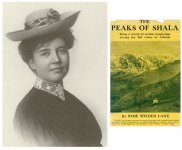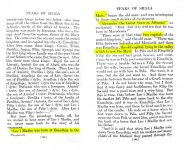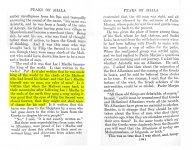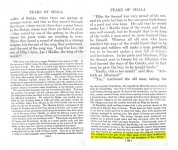This is how you spend the money of the German taxpayers.
Or even building a monument for the horse of Alexander the Great. lol
True.
Great comparison nevertheless...
Follow along with the video below to see how to install our site as a web app on your home screen.

Note: This feature currently requires accessing the site using the built-in Safari browser.
This is how you spend the money of the German taxpayers.
Or even building a monument for the horse of Alexander the Great. lol
I have to get back to everything I read lately, in order to find the references. There were quite long stories told by elders of Theth in 1940-1950, mentioning Alexander the Great as LECI.
Problem is that already by late antiquity we see in sites like Timacum Minus that the V13+L283+CTS1450 soup was already in existence as east as Nish. That’s actually super close to when Z2705 started expanding, just a hundred years earlier perhaps. FTDNA is estimating now the age of the expansion of PH970 (aka Z2705) as 1850ybp. Seems like they are honing in on that underestimation of yfull, which is around 20% I think.
Anyway, for V13 alone to have caused such a phenomenon, assimilating the remaining Illyrian communities in Albania and introducing the language, we would expect to see some major V13 subclade that was in the nucleus of our ethnos mirroring at least to some extent Z2705 - which can be found in any Albanian region and among all Albanian groups.
What come close are BY4461, Y173822 and Y146086 . Non are as uniform though. Other V13 are supper patchy and regional. Same thing for L283 subclades.
Cognomen Timachus, in our opinion, does notnecessarily indicate the dedicant’s origin or his Timaciethnicity. This name may be related to his service inthe Timok Valley. For example, the name Timacensesauxiliarii denoted light cavalry units which controlledimportant communications behind a number of fortifications in the Timok region, and not necessarily unitscomprised of the Timaci people.13 This is confirmed bythe first two distinctive Latin names in the onomasticformula of the dedicant, praenomen – Lucius and nomen– Petronius, which point to a person whose family wasRomanised in the early imperial period. It should benoted that the votive altars to Jupiter Paternus, as a rule,are a testament devoted by strangers abroad to somepaternal deity from their homeland.14Another votive altar to Jupiter Paternus comesfrom Timacum Minus.
A small, limestone pillar with aSTARINAR LXIII/20135611 Ptol. III, 9, 4; Tab. Peut.VIII, 7.12 Jovanovi} S. 1989, 74–78; Petrovi}, Filipovi} 2008, 48–57.13 Petrovi} 1997, 123; Petkovi} 1998, 226–228.14 Mirkovi} 1966, 391–393, sl. 10; Mirkovi}, Du{ani} 1976,49, nos. 9–13, 21, 80; Petrovi} 1979, 35, 76–78, nos. 19–22. – InMoesia Superior, except in Timacum Minus, votive altars dedicatedto Jupiter Paternus are confirmed in Singidunum, Rgotina (Argentares?), Naissus and in the vicinity of Prizren (Theranda?).Fig. 3a. Flavius Bitus’s votive altarFig. 3b. Monogram DD on the Flavius Bitus’s tombstone,detailSl. 3a. Votivni spomenik Flavija BitusaSl. 3b. Monogram DD na spomeniku Flavija Bitusa,detaqabcPETKOVI], ILIJI], Votive altar of Lucius Petronius Timachus (53–72) STARINAR LXIII/201357votive inscription was discovered in a building with ahypocaust, in a Roman settlement west of the fortification in Ravna. The dedicant is Flavius Bitus DD, aThracian immigrant (Fig 3a).15 There is no reliableexplanation in scientific literature for Flavius Bitus’military rank, marked by the abbreviation DD (Fig. 3b).The same markings on the tombstone of Valeria Furniafrom Timacum Minus, raised by her children (Rusticianus, Valerianus, Lucilla, Faestus) and her husbandAelius Rusticus, DD cohortis II Aureliae Dardanorum,with the depiction of dona militaria (torques, armilae,phalerae) above the inscription area, are interpreted byP. Petrovi} as the abbreviation d(onis) d(onatus).16
However, the same author later gives another interpretationof the DD inscription, associated with the participationof cohort II Aureliae Dardanorum in the exploitationof mines in the Upper Timok region – d(rome)d(arius),as member of the camel unit, dromedarii.17 Eventhough the depiction of dona militaria on the tombstone of Aelius Rusticus gave Petrovi} a strong argumentfor deciphering DD as d(onis) d(onatus), he once againoffered alternative interpretations, such as d(ecurio)d(uplarius) or d(ecurio torquatus et) d(uplarius).18 Whatled him to this conclusion was, most likely, the factthat the two letters D were connected by a horizontalline in a specific manner, identical to the tombstone ofFlavius Bitus (Fig. 3b).The marks of the military rank which consist of twoletters D, connected with a horizontal line that endswith oblique serifs on these tombstones, could represent a monogram made up of two D’s, an E, and a T(Fig. 3b–c). In the case of the two epigraphic inscriptions from Ravna, the monogram can be interpreted asd(ecurio) et d(uplarius), even more so because AeliusRusticus’ military decorations (dona militaria) are displayed on his tombstone. The unit in which he served isunmarked on Flavius Bitus’ votive altar, whereas AeliusRusticus was a veteran of cohort II Aureliae Dardanorum. Judging by their gentile names, unlike the majorityof the people in Moesia Superior, the family of FlaviusBitus acquired Roman citizenship during the Flaviandynasty, and the family of Aelius Rusticus did so duringHadrian’s rule, indicating their foreign origins.19 Inthis case, both decorated officers settled in TimacumMinus upon the completion of their military service.20In this context, we will focus on the position andrank of the dedicant Lucius Petronius Timachus: veteranus legionis VII Claudia Severiana Alexandriana exoptione. From his rank’s formula it is evident that hewas a veteran of legion VII Claudia, where he served
https://pdfs.semanticscholar.org/d855/534b208983db0a58d6a6ad71f6abd7141878.pdf
The situation is not so straightforward unfortunately.
This is what i could find, grave classification for 2 J2b2-L283 and 1 E-V13 whom Serb archaeologists think come from same ethnic group likely: https://www.eupedia.com/forum/threa...m-VIDEO/page27?p=638310&viewfull=1#post638310
For the rest, either they are not sure or have no information. We have couple of options here:
1. Timacenses auxiliarii. <= natives or from somewhere else?
2. Aurelia Dardanorum
3. Numeri Dalmatorum
Or a mix of all of them!? Who knows. Timacum Minus is a region far apart from where Dardanians or any Illyrian scretched, that's Moesi/Triballi territory. I tend to believe more the Dardanian or Dalmatian, or a mix of both Dardanian/Dalmatian.
Nuk lodhen kta kojshit. Do durojmë edhe ca.Si keni qenë o burra? A u lodhur ndopak? Mirë, jo keq, 126 faqe.
I15548 was Z1043+ like the sample from Doclea so probably they were not Dalmatian. Most likely Illyrians from North Albania/Monte or Dardanians - considering the CTS1450 sample too (who was interestingly more western autosomally).
Dardanians wil probably end up being similar to Paeonians but with more V13 and additional L283. Maybe some of our V13 subclades I mentioned in my previous post were present among them.
Thanks to all of the evidence, the Thracian theory makes no sense at all.
Also inscription found on illyrian coins and tiles:I actually completely forgot that we have Thracian inscriptions. They literally show no connection to Albanian. Even court jesters like Matzinger & co. state Thracian is unrelated to Albanian.
These morons arguing about a Thracian origin when there's 0 linguistic connection or autosomal connection are getting quite sad. Even their naming conventions are different, ending cities in -para (Dacians in -dava), while Albanians ended tribes names in -et, -at like Illyrians.
Meanwhile, the Messapic inscriptions do show a clear link to Albanian, and Messapics are Illyrian-descended.
Probably founder effect.
Mirditors score 50% Illyrian, Himariotes around 20%.
Target: Mirditë
Distance: 1.7873% / 0.0178728548.2 ALB_Cinamak_Anc 41.0 BGR_IA 10.8 Polish
Target: Himarë
Distance: 2.2925% / 0.02292459
59.8 BGR_IA 20.2 ALB_Cinamak_Anc 20.0 Polish
Target: Mirditë
Distance: 1.7873% / 0.01787285
48.2 ALB_Cinamak_Anc 41.0 BGR_IA 10.8 Polish
Target: Himarë
Distance: 2.2925% / 0.02292459
59.8 BGR_IA 20.2 ALB_Cinamak_Anc 20.0 Polish
Also, why are you using BGR_IA and not BGR_Kapitan_Andreevo which is the actual average for southeast Thrace? BGR_IA doesn't even have ancestry identical to the E-V13 from Thrace.
Nice catch! I personally never looked into this sample, as I thought he is some low coverage R-L51 as reported by the Southern Arc paper. I just looked at his BAM file and I would have to agree with FTDNA that I14688 is in fact R1b-PF7562>PF7563!
At R-PF7562 level, he has GG490/BY856/Y19696+ (3T), then at R-PF7563 level he is showing PF7563+ (1A), with no contradicting or negative reads.
It seems Lazaridis et al. classified him as R-L51 based on SNPs L51 which has two derived and one ancestral/negative read, and E207/Y410/MF659561 which has one derived and one ancestral read. So, unlike the R-PF7562>PF7563 calls, the R-L51 calls are clearly ambiguous.
I think this is a nice development with regards to Albanian Y-DNA. Just in LBA-IA Çinamak site in NE Albania, we have J2b-L283, R1b-CTS9219 aka R1b-CTS1450, and now R1b-PF7563, which together compose ~35-40% of modern Albanian Y-DNA.




Rose W. Lane, a founder of the US Libertarian movement, documented some fantastic myths in Albania.She recorded claims that the ancient Macedonians had two capitals, one in Pella as well as another in the Mat valley in Albania, where they claimed Alexander the Great was born. (from AlbHistory in twitter). I have read similar stories from Rrok Zojzi. Hopefully I can find them.Could you guide me to where Rrok Zojzi collected mentions of Alexander the Great in our folklore?
This thread has been viewed 606523 times.
